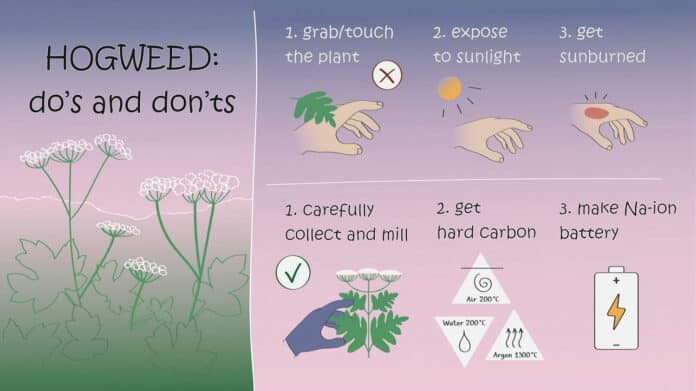Researchers from Moscow State University (MSU) and Skolkovo Institute of Science and Technology (Skoltech) have transmuted a pesky poisonous weed – Sosnowsky’s hogweed – into a high-grade anode material for cheap sodium-ion batteries. These are emerging cost-effective alternatives to lithium-ion batteries for uses where compact size is not crucial, such as solar and wind farms.
Sodium-ion batteries use sodium ions and release them over many cycles, which is crucial for battery operation. It does not significantly expand in size upon charge-up. Unlike Li-ion batteries, sodium-ion batteries are cheap, reasonably easy to synthesize and dispose of, and do not create significant fire hazards.
“We thought, wouldn’t it be fun to take something as nasty and objectionable as hogweed and make something useful out of it,” study co-author Zoya Bobyleva of Lomonosov Moscow State University commented. “The thing about hard carbon materials used in sodium-ion battery anodes is you can make them from biomass of virtually any origin. No one has considered hogweed before. But it turned out pretty well!”
Sosnowsky’s hogweed is an invasive plant that causes severe skin burns. It is especially hazardous in direct contact with human skin. Exposure to light causes inflammation of the skin that comes into contact with giant hogweed sap, which contains toxic substances that are activated by sunlight and also by artificial UV rays.
The hard carbon produced by the MSU-Skoltech team exhibited a Coulombic efficiency of 87%, which is on par with the best-reported results for hard carbons synthesized from other raw materials. As for the energy storage capacity, at about 260 mAh/g, the material falls short of the best results reported elsewhere – around 300 mAh/g – but is still reasonably good.
The MSU-Skoltech team tested three popular approaches to hard carbon synthesis. First, there’s direct carbonization – heating the biomass to 1,300 degrees Celsius in an atmosphere without oxygen. Alternatively, you can treat the biomass with an acid to remove metallic and other impurities prior to carbonization. The approach resulted in a significantly higher Coulombic efficiency. Or you can boil the hogweed biomass in water in a closed reactor – this produces very small carbon-containing spheres. While all three approaches led to comparable energy storage capacity, heat treatment with prior impurity removal resulted in the best Coulombic efficiency.
“The demand for rechargeable accumulators will continue to grow. And when it comes to stationary batteries deployed at industrial facilities and in the production of renewable energy to even out fluctuations in available sunlight or wind power, sodium-ion technology appears very promising. These batteries will be much cheaper, and while they might be heavier and bulkier, it won’t be much of a problem for the relevant applications,” study co-author Professor Artem Abakumov said; he heads the Center for Energy Science and Technology at Skoltech.
Journal reference:
- Grigorii P. Lakienko, Zoya V. Bobyleva, Maria O. Apostolova, Yana V. Sultanova, Andrey K. Dyakonov, Maxim V. Zakharkin, Nikita A. Sobolev, Anastasia M. Alekseeva, Oleg A. Drozhzhin, Artem M. Abakumov, and Evgeny V. Antipov. Sosnowskyi hogweed-based hard carbons for sodium-ion batteries. Batteries 2022; DOI: 10.3390/batteries8100131
